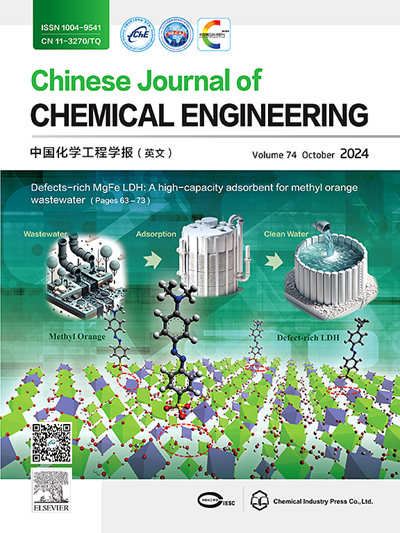Mechanism of extracting poorly-caking components from Shenhua long-flame coal using [N4441][Cl]
IF 3.7
3区 工程技术
Q2 ENGINEERING, CHEMICAL
引用次数: 0
Abstract
The effects of different kinds of ionic liquids (ILs) on the caking property of Shenhua long-flame coal (SHLC) were studied. SHLC and its residue after [N4441][Cl] treatment under optimum conditions were characterized by Fourier transform infrared spectroscopy (FT-IR), thermogravimetric analysis (TG), X-ray diffraction (XRD), X-ray photoelectron spectroscopy (XPS), Raman spectroscopy, and pyrolysis-gas chromatography and mass-spectrometric analysis (Py-GC/MS). The results showed that the ILs used could extract the poorly-caking components from SHLC, and [N4441][Cl] with C3H6O as a solvent exhibited the best effect among the ILs and solvents used. [N4441][Cl] could destroy the H bonds in SHLC, and the structure of the cross-linked macromolecules of SHLC was loosed, leading to the release of the small molecules within the macromolecular framework of SHLC. Additionally, [N4441][Cl] could easily penetrate into the interior of the relaxed SHLC and break the weak covalent bonds (e.g., C‒O bonds) of the macromolecules of SHLC. As a result, aromatic hydrocarbons with 3‒5 rings and aliphatic side chains, which are the precursor of the poorly-caking components, were formed and were then extracted from SHLC by C3H6O. Consequently, [N4441][Cl] treatment could decrease the caking property, thermal ability, and macromolecular size of SHLC.
[N4441][Cl]萃取神华长焰煤中差结块组分的机理
研究了不同种类离子液体对神华长焰煤结块性能的影响。采用傅里叶变换红外光谱(FT-IR)、热重分析(TG)、x射线衍射(XRD)、x射线光电子能谱(XPS)、拉曼光谱、热解气相色谱和质谱分析(Py-GC/MS)等方法对[N4441][Cl]在最佳条件下处理后的SHLC及其残留物进行了表征。结果表明:所采用的ILs能有效地提取出SHLC中不易结块的组分,其中以c3h60为溶剂的[N4441][Cl]萃取效果最好。[N4441][Cl]可以破坏SHLC中的H键,使SHLC交联大分子的结构松动,导致SHLC大分子框架内的小分子释放。此外,[N4441][Cl]可以很容易地渗透到松弛SHLC的内部,破坏SHLC大分子的弱共价键(如C-O键)。形成具有3-5环和脂肪侧链的芳香烃,这些芳香烃是低结块组分的前驱体,然后用c3h60从SHLC中提取。因此,[N4441][Cl]处理可以降低SHLC的结块性能、热性能和大分子尺寸。
本文章由计算机程序翻译,如有差异,请以英文原文为准。
求助全文
约1分钟内获得全文
求助全文
来源期刊

Chinese Journal of Chemical Engineering
工程技术-工程:化工
CiteScore
6.60
自引率
5.30%
发文量
4309
审稿时长
31 days
期刊介绍:
The Chinese Journal of Chemical Engineering (Monthly, started in 1982) is the official journal of the Chemical Industry and Engineering Society of China and published by the Chemical Industry Press Co. Ltd. The aim of the journal is to develop the international exchange of scientific and technical information in the field of chemical engineering. It publishes original research papers that cover the major advancements and achievements in chemical engineering in China as well as some articles from overseas contributors.
The topics of journal include chemical engineering, chemical technology, biochemical engineering, energy and environmental engineering and other relevant fields. Papers are published on the basis of their relevance to theoretical research, practical application or potential uses in the industry as Research Papers, Communications, Reviews and Perspectives. Prominent domestic and overseas chemical experts and scholars have been invited to form an International Advisory Board and the Editorial Committee. It enjoys recognition among Chinese academia and industry as a reliable source of information of what is going on in chemical engineering research, both domestic and abroad.
 求助内容:
求助内容: 应助结果提醒方式:
应助结果提醒方式:


